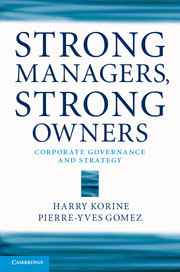Book contents
- Frontmatter
- Contents
- List of Figures
- List of Tables
- Foreword
- Acknowledgments
- Introduction
- Part I Changes in the identity of ownership and management
- 1 Change in ownership
- 2 Change in management
- Concluding remarks
- Part II Changes in the form of ownership and organization
- Part III Changes in strategy
- Part IV Implications for corporate governance
- Notes
- Index
2 - Change in management
from Part I - Changes in the identity of ownership and management
Published online by Cambridge University Press: 05 December 2013
- Frontmatter
- Contents
- List of Figures
- List of Tables
- Foreword
- Acknowledgments
- Introduction
- Part I Changes in the identity of ownership and management
- 1 Change in ownership
- 2 Change in management
- Concluding remarks
- Part II Changes in the form of ownership and organization
- Part III Changes in strategy
- Part IV Implications for corporate governance
- Notes
- Index
Summary
The executive defines strategies and implements operational decisions to direct the company, within the framework of the powers granted by shareholders and the board of directors. Instances of executive succession therefore represent a prime opportunity for ownership to confirm the adopted course or to set new strategic priorities. However, it is wrong to regard the executive as a mere instrument of ownership. In some cases of executive succession, such as where a new executive is put in place by shareholders seeking strategic change (i.e., private equity), he or she does indeed stick very closely to the designs of ownership. Generally, however, it is more accurate to think of the new executive as an independent actor whose ability to make things happen depends upon his/her relationship with shareholders and the board of directors.
When does a firm experience a change in management? In the case of a firm that is performing to the satisfaction of its shareholders and where there is broad agreement over strategy, the question of executive succession arises in the context of passing the torch, from one generation of leadership to the next: age or other interests prompt the current executive to step down. Although this process is never easy, it is rarely explicitly concerned with strategy, except in stressing continuity. Where the firm is in danger or where there is substantial disagreement in the ownership over strategy, on the other hand, executive succession represents the chance for a real break with the past and is very much concerned with strategy. The focus is on choosing an executive who will find a new way to get the firm on track again.
- Type
- Chapter
- Information
- Strong Managers, Strong OwnersCorporate Governance and Strategy, pp. 42 - 57Publisher: Cambridge University PressPrint publication year: 2013



